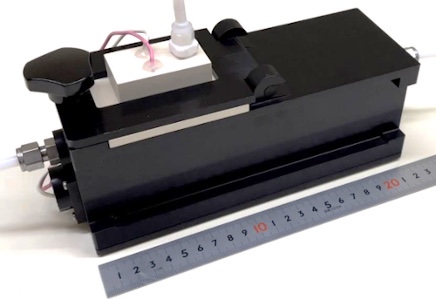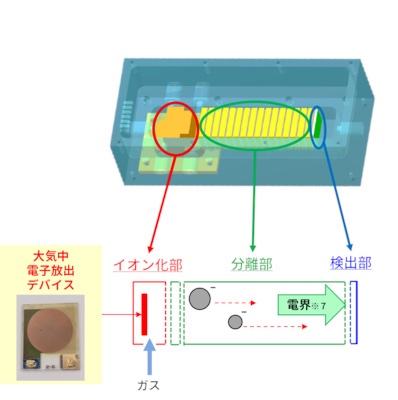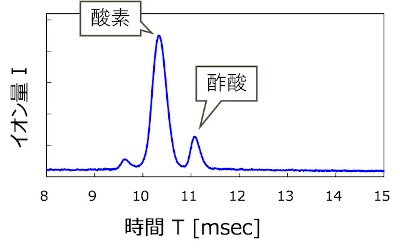


Trace substances in the air: “visualization” of gas components!
– Sharp’s IMS (Ion Mobility Spectrometry) Analyzer –
sharp:
We have developed an IMS analyzer that can identify ultra-trace gas components in the atmosphere.
Equipped with “ionization technology by original atmospheric electron emission device”.
IMS (Ion Mobility Spectrometry):
Ionize gas components in the atmosphere and identify them based on their speed of movement (mobility).
Conventional IMS analyzer:
Discharge method:
When ionizing with the discharge method, “using radioactive substances and generating ozone” is a problem.
Currently, the discharge method is the mainstream.
It was limited to a small number of uses*4, such as detecting explosives and drugs.
This IMS analyzer:
Atmospheric electron emission formula:
We have developed our own by making use of the knowledge we have gained in the development of MFPs.
Equipped with an “atmospheric electron emission device”.
Atmospheric electron emission device:
“Stable electron emission, which was conventionally thought to be difficult only in a vacuum,” is realized in the atmosphere.
When the ionized component moves through the analyzer,
“Spectrum waveform of time (horizontal axis) and ion amount (vertical axis)” is compared with the database.
Identify “trace components and concentrations”.
NEDO projects:
Our company participates in the NEDO: IoT Innovative Sensing Technology Development*5 Project.
The theme is “IMS breath analysis system by atmospheric electron emission ionization”.
Developed IMS analysis technology:
Using this analyzer, it was confirmed that “an ultra-trace component of 0.1 ppb*6 can be detected.”
Detects ultra-trace components:
We also confirmed that “more than 10 different components, such as ammonia and acetic acid, can be identified.”
Outcomes of this project:
Exhibited at Tokyo Big Sight “nano tech 2023” from February 1st (Wednesday) to 3rd (Friday) this year.
Future development
Aiming for application to breath analysis,
We will work on the development of “technology to visualize trace substances in the air”.
News Release: Sharp
https://corporate.jp.sharp/news/230124-b.html
Traces de substances dans l’air : « visualisation » des composants gazeux !
– Analyseur IMS (Ion Mobility Spectrometry) de Sharp –
pointu:
Nous avons développé un analyseur IMS qui peut identifier les composants de gaz ultra-traces dans l’atmosphère.
Équipé de la “technologie d’ionisation par dispositif original d’émission d’électrons atmosphériques”.
IMS (spectrométrie de mobilité ionique) :
Ionisez les composants gazeux dans l’atmosphère et identifiez-les en fonction de leur vitesse de déplacement (mobilité).
Analyseur IMS conventionnel :
Méthode de décharge :
Lors de l’ionisation avec la méthode de décharge, “l’utilisation de substances radioactives et la génération d’ozone” est un problème.
Actuellement, la méthode de décharge est le courant dominant.
Il était limité à un petit nombre d’utilisations*4, comme la détection d’explosifs et de drogues.
Cet analyseur IMS :
Formule d’émission d’électrons atmosphériques :
Nous avons développé le nôtre en utilisant les connaissances que nous avons acquises dans le développement des MFP.
Équipé d’un “dispositif d’émission d’électrons atmosphériques”.
Dispositif d’émission d’électrons atmosphérique :
“L’émission stable d’électrons, que l’on pensait classiquement difficile uniquement dans le vide”, est réalisée dans l’atmosphère.
Lorsque le composant ionisé se déplace dans l’analyseur,
La “forme d’onde spectrale du temps (axe horizontal) et de la quantité d’ions (axe vertical)” est comparée à la base de données.
Identifier les “éléments traces et leurs concentrations”.
Projets NEDO :
Notre société participe au projet NEDO : IoT Innovative Sensing Technology Development*5.
Le thème est “Système d’analyse de l’haleine IMS par ionisation par émission d’électrons atmosphériques”.
Développement de la technologie d’analyse IMS :
À l’aide de cet analyseur, il a été confirmé qu'”une composante ultra-trace de 0,1 ppb*6 peut être détectée”.
Détecte les composants ultra-traces :
Nous avons également confirmé que “plus de 10 composants différents, tels que l’ammoniac et l’acide acétique, peuvent être identifiés”.
Résultats de ce projet :
Exposée au Tokyo Big Sight « nano tech 2023 » du 1er (mercredi) au 3 (vendredi) février de cette année.
Développement futur
Visant l’application à l’analyse de l’haleine,
Nous travaillerons sur le développement d’une « technologie pour visualiser les traces de substances dans l’air ».
Communiqué de presse : Sharp
Spurenstoffe in der Luft: „Visualisierung“ von Gasbestandteilen!
– IMS (Ionenmobilitätsspektrometrie)-Analysator von Sharp –
scharf:
Wir haben einen IMS-Analysator entwickelt, der Ultraspurengaskomponenten in der Atmosphäre identifizieren kann.
Ausgestattet mit “Ionisationstechnologie durch originales atmosphärisches Elektronenemissionsgerät”.
IMS (Ionenmobilitätsspektrometrie):
Gasbestandteile in der Atmosphäre ionisieren und anhand ihrer Bewegungsgeschwindigkeit (Mobilität) identifizieren.
Herkömmlicher IMS-Analysator:
Entlademethode:
Beim Ionisieren mit dem Entladungsverfahren ist die „Verwendung radioaktiver Stoffe und die Erzeugung von Ozon“ ein Problem.
Derzeit ist die Entladungsmethode der Mainstream.
Es war auf eine kleine Anzahl von Anwendungen*4 beschränkt, wie z. B. das Aufspüren von Sprengstoffen und Drogen.
Dieser IMS-Analysator:
Formel für atmosphärische Elektronenemission:
Wir haben unsere eigenen entwickelt, indem wir uns das Wissen zunutze gemacht haben, das wir bei der Entwicklung von MFPs gewonnen haben.
Ausgestattet mit einem “Atmospheric Electron Emission Device”.
Atmosphärisches Elektronenemissionsgerät:
„Stabile Elektronenemission, die herkömmlicherweise nur im Vakuum als schwierig galt“, wird in der Atmosphäre realisiert.
Wenn sich die ionisierte Komponente durch den Analysator bewegt,
“Spektrumwellenform der Zeit (horizontale Achse) und der Ionenmenge (vertikale Achse)” wird mit der Datenbank verglichen.
Identifizieren Sie „Spurenbestandteile und Konzentrationen“.
NEDO-Projekte:
Unser Unternehmen nimmt am Projekt NEDO: IoT Innovative Sensing Technology Development*5 teil.
Das Thema ist “IMS-Atemanalysesystem durch atmosphärische Elektronenemissionsionisation”.
Entwickelte IMS-Analysetechnologie:
Unter Verwendung dieses Analysators wurde bestätigt, dass „eine Ultraspurenkomponente von 0,1 ppb*6 nachgewiesen werden kann“.
Erkennt Ultraspurenkomponenten:
Wir haben auch bestätigt, dass “mehr als 10 verschiedene Komponenten wie Ammoniak und Essigsäure identifiziert werden können”.
Ergebnisse dieses Projekts:
Ausgestellt auf der Tokyo Big Sight „nano tech 2023“ vom 1. Februar (Mittwoch) bis 3. Februar (Freitag) dieses Jahres.
Zukünftige Entwicklung
Angestrebt wird eine Anwendung in der Atemanalyse,
Wir werden an der Entwicklung einer „Technologie zur Visualisierung von Spurenstoffen in der Luft“ arbeiten.
Pressemitteilung: Scharf